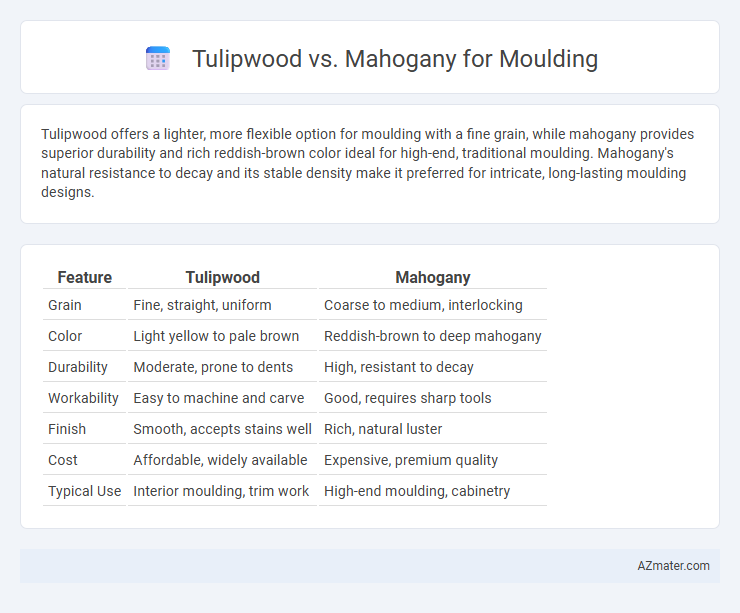Tulipwood offers a lighter, more flexible option for moulding with a fine grain, while mahogany provides superior durability and rich reddish-brown color ideal for high-end, traditional moulding. Mahogany's natural resistance to decay and its stable density make it preferred for intricate, long-lasting moulding designs.
Table of Comparison
| Feature | Tulipwood | Mahogany |
|---|---|---|
| Grain | Fine, straight, uniform | Coarse to medium, interlocking |
| Color | Light yellow to pale brown | Reddish-brown to deep mahogany |
| Durability | Moderate, prone to dents | High, resistant to decay |
| Workability | Easy to machine and carve | Good, requires sharp tools |
| Finish | Smooth, accepts stains well | Rich, natural luster |
| Cost | Affordable, widely available | Expensive, premium quality |
| Typical Use | Interior moulding, trim work | High-end moulding, cabinetry |
Introduction: Tulipwood vs Mahogany for Moulding
Tulipwood offers a lighter, more affordable option with a fine, straight grain ideal for intricate moulding patterns, while mahogany provides a rich reddish-brown hue and exceptional durability favored in high-end architectural details. Tulipwood's workability suits detailed carvings and paint finishes, whereas mahogany's natural luster and resistance to decay make it preferred for stain finishes and areas requiring long-lasting strength. Choosing between tulipwood and mahogany for moulding depends on budget, desired aesthetic, and the level of wear the moulding will endure.
Wood Characteristics and Appearance
Tulipwood features a pale yellow to light reddish-brown hue with a subtle grain pattern, offering a smooth texture ideal for detailed moulding work, while mahogany displays rich reddish-brown tones with a straight grain and a fine, even texture that enhances elegant, high-end moulding designs. Tulipwood is lighter and easier to work with, providing good stability and resistance to warping, whereas mahogany is denser, more durable, and valued for its natural resistance to decay, making it suitable for long-lasting moulding applications. Both woods take finishes well, but mahogany's deep color naturally adds warmth and sophistication, whereas tulipwood's lighter appearance complements contemporary or minimalist interior styles.
Durability and Strength Comparison
Tulipwood offers moderate durability and strength, making it suitable for interior moulding where resistance to wear and impact is essential but not extreme. Mahogany is renowned for its exceptional durability and high strength, providing superior resistance to dents, warping, and moisture, ideal for high-traffic areas and long-lasting moulding applications. When comparing Tulipwood vs Mahogany for moulding, Mahogany outperforms Tulipwood in both strength and durability, ensuring extended lifespan and minimal maintenance.
Workability and Machining Properties
Tulipwood offers excellent workability due to its moderate hardness and fine grain, making it easy to shape and sand for detailed moulding designs. Mahogany, valued for its stability and smooth texture, machines well with minimal risk of tear-out, delivering clean edges and intricate profiles. Both woods respond well to common woodworking tools, but tulipwood's lighter weight and consistent grain often provide more precise control during intricate moulding fabrication.
Finishing and Paint Adhesion
Tulipwood offers a smooth grain that allows for excellent paint adhesion, making it ideal for brightly colored or detailed moulding finishes. Mahogany's dense, oily texture can resist paint absorption, often requiring a primer to ensure even finishing and adherence. Choosing Tulipwood over Mahogany for moulding can result in a more consistent and durable painted surface, especially for intricate designs.
Cost and Availability
Tulipwood is generally more affordable and widely available compared to mahogany, making it a cost-effective choice for moulding projects. Mahogany, prized for its rich color and durability, commands a higher price and is often sourced from limited, sustainable suppliers, impacting its accessibility. Choosing tulipwood can significantly reduce expenses while maintaining acceptable quality for most interior moulding applications.
Environmental Impact and Sustainability
Tulipwood is sourced primarily from fast-growing trees in North America, making it a more sustainable and renewable option for moulding compared to mahogany, which often comes from slower-growing tropical hardwoods with higher ecological risks. Mahogany harvesting has been linked to deforestation and habitat loss, whereas tulipwood's growth cycle allows for better forest management and lower carbon footprint. Choosing tulipwood for moulding supports environmental conservation efforts by reducing the demand for endangered tropical hardwoods and promoting sustainable forestry practices.
Common Applications in Moulding
Tulipwood is commonly used for interior trim and decorative moulding due to its fine grain and smooth finish, making it ideal for painted or stained applications. Mahogany is preferred for high-end moulding projects where durability, rich color, and natural luster are essential, especially in classic or historic-style interiors. Both woods offer stability and workability, but mahogany is often chosen for more prestigious moulding requiring a deep, luxurious appearance.
Maintenance and Longevity
Tulipwood moulding offers moderate durability with a smooth finish but requires regular sealing and maintenance to prevent wear and moisture damage. Mahogany moulding is renowned for its exceptional longevity and resistance to rot and insects, demanding less frequent upkeep while maintaining its rich color over time. Both woods benefit from periodic refinishing, but mahogany's natural resilience makes it a superior choice for long-term moulding applications.
Which is Best: Tulipwood or Mahogany for Moulding?
Tulipwood offers a lighter color with a fine, straight grain, making it ideal for modern, bright interiors and easy staining, while mahogany provides a rich, reddish-brown hue and superior durability favored in traditional or high-end moulding projects. Mahogany's natural resistance to moisture and decay outperforms tulipwood, making it better suited for environments with higher humidity or wear. For budget-conscious applications with consistent grain and lighter finish, tulipwood is best; for premium, long-lasting moulding with classic appeal, mahogany is the preferred choice.

Infographic: Tulipwood vs Mahogany for Moulding
 azmater.com
azmater.com